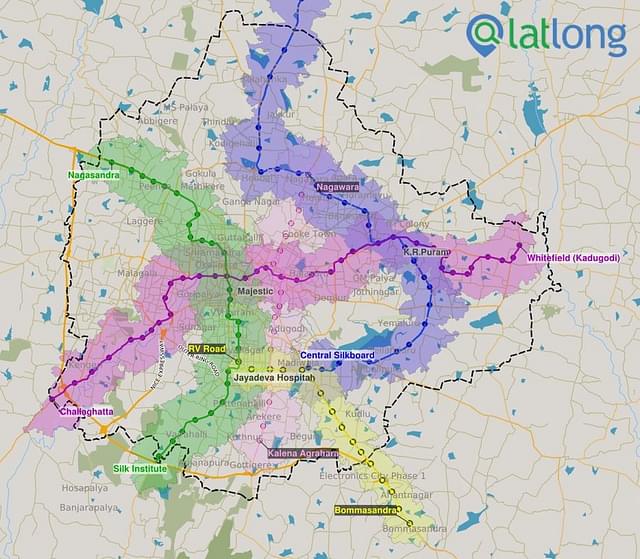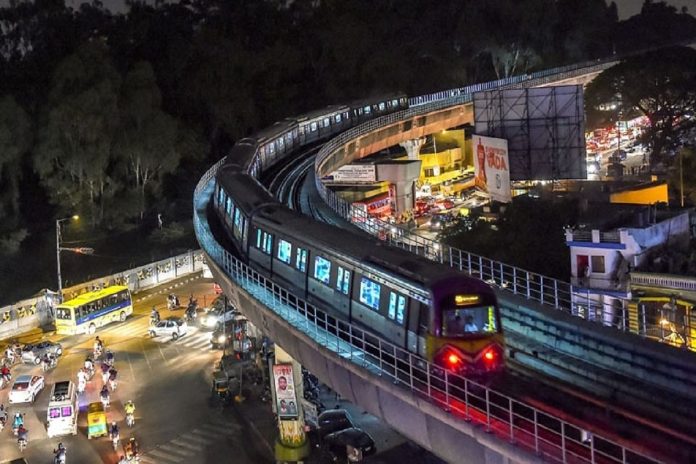Aiming to enhance further connectivity in Bengaluru, the Bangalore Metro Rail Corporation Limited (BMRCL) recently put forward a plan to extend the Namma Metro network in Bengaluru by 129 km in what is termed Phase-4.
However, this proposed expansion, specifically targeting the connection of suburban regions, has provoked diverse reactions among Bengaluru residents.
Some contend that Bengaluru is currently executing a crucial 317 km network, one of the major advancements addressing the city’s transit challenges, which should take precedence over planning additional expansion ventures.
The Extension To The Suburbs
In December last year, the new proposal was set in motion under Karnataka Deputy CM, DK Shivkumar, who serves as the Bengaluru City Development Minister, to seek support from the central government for network expansion.
This plan includes introducing a new line and extending the existing purple and green lines in four directions — towards Bidadi (Mysuru Road), Harohalli (Kanakapura Road), Attibele (Hosur Road), and Kunigal Cross (Tumakuru Road, near Nelamangala).
With Bengaluru rapidly expanding in all directions, the identified corridors aim to establish advanced connectivity to these emerging suburban areas, anticipating future growth.
Given the city’s persistent challenges with traffic congestion, marked by high vehicular density concentrated in Bengaluru’s central core, such expansion efforts hold promise for the residents to sprawl towards the suburbs while remaining tethered to the main city.
However, while the proposal paints a picture of expected future benefits, several experts and citizens view it as a premature move by the government, arguing that the plan deviates from the proposed development framework, lacks coherence and the emphasis should be on a unified mobility plan for the city’s expansion.
Reviews On The Expansion Plans
Bengaluru South MP Tejasvi Surya called this new expansion plan “amusing.” He said, “Instead of accelerating work in Bengaluru’s core area, it makes no point to extend it to areas outside the BBMP (Bruhat Bengaluru Mahanagara Palike) limits when none of the 129 km of proposed length was part of the Comprehensive Mobility Plan-2020.”
“It adds no value to the needs of citizens, considering the lower density of the population in the suburbs. The core area of the city should be the priority,” he added.
At present, the metro network proposed for Bengaluru spans 317 km, of which 74 km has been fully operational. This includes the recent launches, that made the 43.49 km purple line fully operational connecting Whitefield to Challaghatta.

As the current network has been proven to transform the transit and provide relief to the working population of the city, the citizens eagerly wait for the remaining networks to be completed sooner, with no new challenges or delays.
Further, this new proposal diverges from the network proposed in the comprehensive mobility plan of 2020, aimed at addressing infrastructure gaps in Bengaluru, which includes the metro, suburban rail, bus, and along with several other planned initiatives.
Meanwhile, these new lines are part of the ideas put forth by the new state government, much like the previously suggested “tunnel vision” for roads in the city — all of which are currently at feasibility stages and in process of seeking funding from the central government.
As reported by Deccan Herald, a senior official said that the BMRCL had sought funds from the state government to study the feasibility of these lines.
“All five lines were suggested for study based on representation we received from different stakeholders. The feasibility survey will provide clarity on the necessity of the project.” the official said, as per the DH report.
He conceded that the lines suggested in the CMP should have been taken first.
Srinivas Alavilli, Fellow, WRI India, tells Swarajya “It is good that the people are thinking of expansion plans, given Bengaluru’s continuous growth, and distributed development to the suburbs is vital for its future. However, this expansion plan seems arbitrary. It is natural to think of expansion networks with growth, but what matters is — how, where and when?”
For the same, the previous BJP government enacted the Bengaluru Metropolitan Land Transport Authority (BMLTA) Bill 2022, to bring a unified metropolitan transport authority (UMTA), similar to those in cities like London and several others.
The UMTA aims to bring about better integration and management of city’s urban mobility.
He adds, “Determining the metro routes shouldn’t solely rely on the metro agency or government, it requires involvement from bodies like the BMLTA (which is yet to be formed by the current government), which can determine feasible routes, considering the integration of other proposed modes, such as the suburban railways in this case.”
“Many of the proposed routes of the suburban rail align closely with these proposed expansions. Hence, concentrating resources in the same area, proposing different modes to serve the same purpose, may not be the most prudent choice, at this stage for the city.”, added another expert.
Bengaluru has long been suffering chaotic transit environments, but now the metro’s operations in crucial parts of the city show a turning point, relieving the city roads and people for their daily commute.
With these long-awaited changes trickling in only now, the people of Bengaluru remain skeptical about embracing these new initiatives, which may add complexities, and delays to the much-needed infrastructure development.
This has also been heightened by the economic challenges apparent with the present Karnataka government.
As per a recent Swarajya article, in Karnataka, the deputy Chief minister recently lamented the lack of funds for developmental works in constituencies.
Despite the Congress government being just seven months old in Karnataka, there are already uncertainties surrounding the progress of infrastructure projects in the state.


